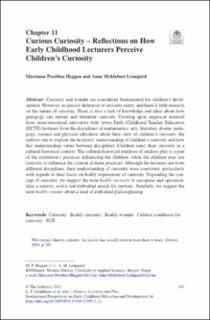| dc.contributor.author | Heggen, Marianne Presthus | |
| dc.contributor.author | Lynngård, Anne Myklebust | |
| dc.date.accessioned | 2021-09-01T08:23:44Z | |
| dc.date.available | 2021-09-01T08:23:44Z | |
| dc.date.created | 2021-08-02T15:57:13Z | |
| dc.date.issued | 2021 | |
| dc.identifier.citation | Heggen, M. P., & Lynngård, A. M. (2021). Curious curiosity – reflections on how early childhood lecturers perceive children’s curiosity. In L. T. Grindheim, H. V. Sørensen, & A. Rekers (Eds.), Outdoor learning and play: Pedagogical practices and children’s cultural formation (pp. 183–201). Springer International Publishing. | en_US |
| dc.identifier.isbn | 978-3-030-72594-5 | |
| dc.identifier.uri | https://hdl.handle.net/11250/2772137 | |
| dc.description.abstract | Curiosity and wonder are considered fundamental for children’s development. However, no precise defnition of curiosity exists, and there is little research on the nature of curiosity. There is also a lack of knowledge and ideas about how pedagogy can sustain and stimulate curiosity. Drawing upon empirical material from semi-structured interviews with seven Early Childhood Teacher Education (ECTE) lecturers from the disciplines of mathematics, arts, literature, drama, pedagogy, science and physical education about their view of children’s curiosity, the authors aim to explore the lecturers’ understanding of children’s curiosity and how this understanding varies between disciplines. Children enact their curiosity in a cultural-historical context. The cultural-historical tradition of outdoor play is a part of the institution’s practices infuencing the children, while the children may use curiosity to infuence the content of these practices. Although the lecturers are from different disciplines, their understanding of curiosity were consistent, particularly with regards to their focus on bodily expressions of curiosity. Expanding the concept of curiosity, we suggest the term bodily curiosity to recognise and operationalise a sensory, active and embodied search for answers. Similarly, we suggest the term bodily wonder about a kind of embodied philosophising. | en_US |
| dc.language.iso | eng | en_US |
| dc.publisher | Springer | en_US |
| dc.relation.ispartof | Outdoor Learning and Play Pedagogical Practices and Children's Cultural Formation | |
| dc.relation.uri | https://www.springer.com/gp/book/9783030725945 | |
| dc.rights | Navngivelse 4.0 Internasjonal | * |
| dc.rights.uri | http://creativecommons.org/licenses/by/4.0/deed.no | * |
| dc.subject | curiosity | en_US |
| dc.subject | bodily curiosity | en_US |
| dc.subject | bodily wonder | en_US |
| dc.subject | cultural conditions for curiosity | en_US |
| dc.subject | ECE | en_US |
| dc.title | Curious Curiosity – Reflections on How Early Childhood Lecturers Perceive Children’s Curiosity | en_US |
| dc.type | Chapter | en_US |
| dc.type | Peer reviewed | en_US |
| dc.description.version | publishedVersion | en_US |
| dc.rights.holder | © The Author(s) 2021 | en_US |
| dc.subject.nsi | VDP::Samfunnsvitenskap: 200::Pedagogiske fag: 280::Allmennpedagogikk: 281 | en_US |
| dc.source.pagenumber | 183-201 | en_US |
| dc.identifier.doi | 10.1007/978-3-030-72595-2_11 | |
| dc.identifier.cristin | 1923500 | |
| dc.relation.project | Norges forskningsråd: 275575 | en_US |
| cristin.ispublished | true | |
| cristin.fulltext | original | |

